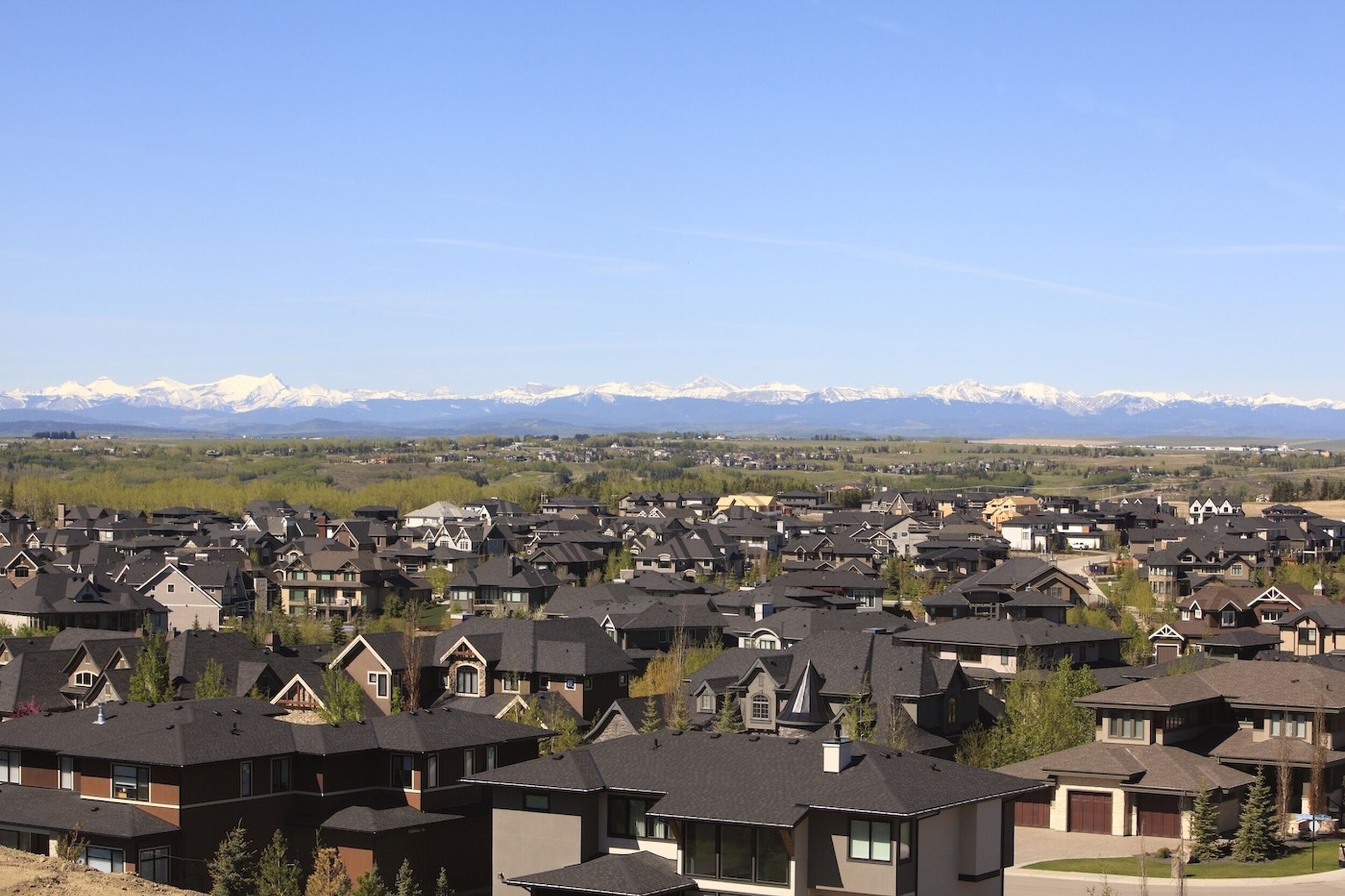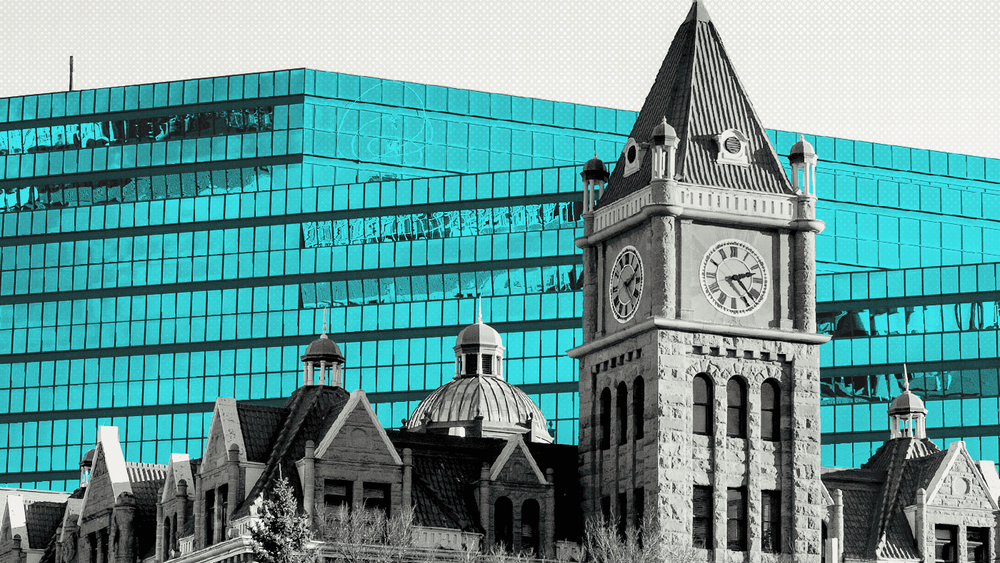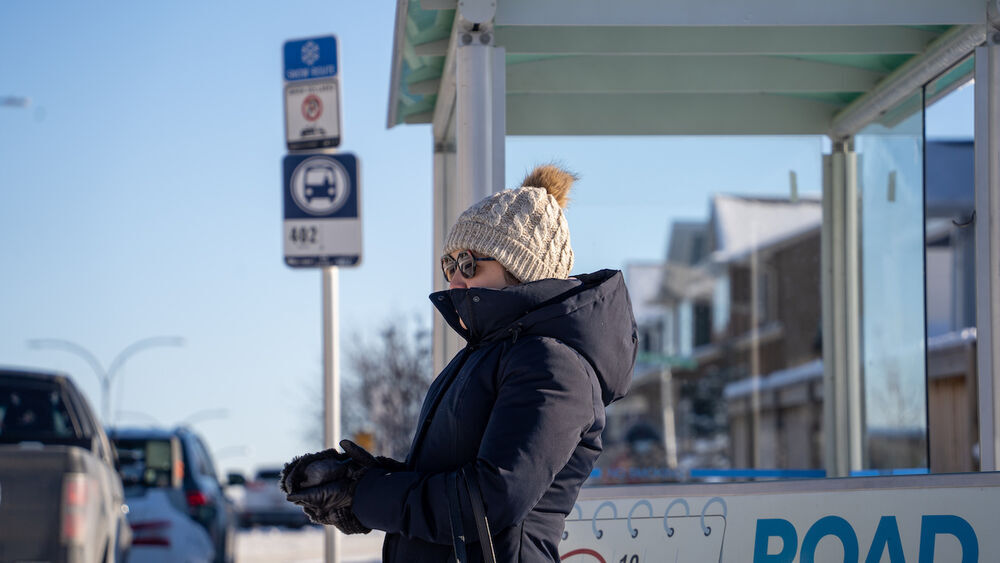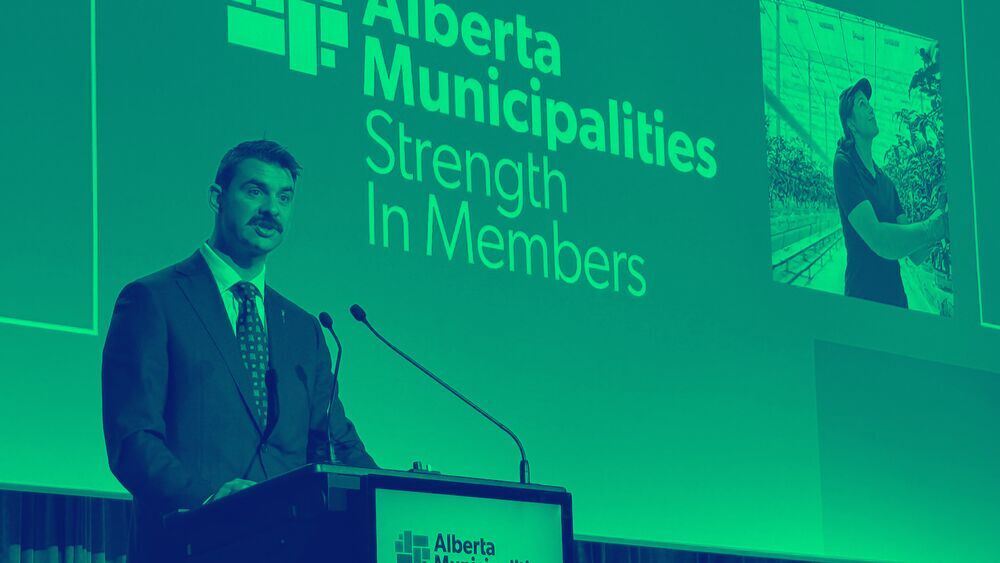
Looking west from Calgary. Photo: iStock/constantgardener
Can the suburbs help fight against climate change?
Digging beyond urban/suburban polarization.
In the summer of 2020, after renting in the southwest community of Evergreen for four and a half years, Farkhod Fayzullaev and his wife began their search to buy a house roomy enough to comfortably accommodate a family of five, as well as space to work from home.
For five months, the Fayzullaevs scoured Mahogany, Auburn Bay, and other suburban communities in Calgary’s south, looking for what would become the first home that they owned. “We compared the prices of new homes versus older homes,” Fayzullaev said, noting that back then, house prices in an older suburb were similar to those on the outskirts of the city. “So we decided to go with a newer house.”
Besides house prices, some of the factors they considered included proximity to amenities like schools and shopping, as well as transit.
They ended up buying a new-build single-family home in Yorkville, a new development in the far southwest. “You’re pretty much maintenance-free for maybe 10 years, which is good,” Fayzullaev said about buying in a new community. “And we didn’t have to have a realtor, which is huge.”
But in the midst of a climate emergency, what may seem like a cost-effective choice for Calgarians such as the Fayzullaevs is often met with scorn in progressive circles as the ever-growing footprint of suburban sprawl in Calgary is not only environmentally unsustainable, but its associated costs are subsidized by taxpayers across the city.
For Erin Stang Chrusch, who lives in Tuscany, a suburban community in Calgary’s northwest established in the late ‘90s, this urban/suburban divide pits communities against each other.
“I understand there’s a cost to all this building out that needs to be balanced out with affordability,” she said. “I think we can have that conversation without demonizing people for where they choose to live.”
Under the pressures [of] climate change, the suburbs now have to become spaces of innovation.
Indeed, according to Roger Keil, a professor of environmental studies and research chair in global sub/urban studies at York University in Toronto, to become more sustainable, cities need to start doing something with the suburbs, rather than doing something about them.
A 2022 book chapter Keil co-authored about the idea of “retrofitting suburbia” notes that “while there may be much to criticize about the suburbs, criticism alone will not help create a more sustainable, vibrant and… resilient suburbia.”
So-called suburbia isn't simple
In writing about the perils of suburban monotony in her momentous 1961 book, The Death and Life of Great American Cities, Jane Jacobs had great influence on how we perceive the suburbs today.
“In seeking visual order, cities are able to choose among three broad alternatives,” she wrote. “They can aim for areas of homogeneity which look homogenous, and get results depressing and disorienting. They can aim for areas of homogeneity which try not to look homogenous, and get results of vulgarity and dishonesty. Or they can aim for areas of great diversity.”
Ever since, urbanists and city-builders have dismissed the suburbs as homogenous “blandscapes” and aimed at their transformation into Jacobs’s urban utopia, a reenactment of New York City’s West Village, via movements like new urbanism and smart growth. But so far, evidence of the success of these trends in building more sustainable cities is limited, in Calgary and elsewhere.
The suburbs need help because they are [not only] mono-cultures of residential areas, but also of commercial and industrial areas.
No matter how dense, livable, or walkable a neighbourhood is, our contemporary way of life requires suburban development to support it, Keil argues. “When we have these ideas about walkable, car-free downtowns where you have a coffee shop and a patio on every street corner, and you have happy people consuming, you don’t see the flip side,” he said, listing the logistical services and the people making city life possible, from warehouses and storage facilities to delivery trucks and drivers.
“The suburbs need help because they are [not only] mono-cultures of residential areas, but also of commercial and industrial areas.”
In other words, one Calgarian’s low carbon footprint in the inner city is made possible by those living and working on the outskirts of the city.
Moreover, density alone won’t address the climate challenge, Keil says, as the goal should be to provide amenities and employment that would reduce the number of trips outside one’s neighbourhood—which remains a challenge in Calgary.
In 2021, only one in five Calgarians lived within a walkable distance from amenities, and most walkable areas are concentrated in the inner city. And this is not because suburbanites just want to drive everywhere.
For Kim Winiski, who lives in Lake Bonavista, a 1960s suburb in the southeast of the city, life in the suburbs has allowed her two children to grow up in a walkable neighbourhood, surrounded by friends. “It’s the kind of neighbourhood that my kids can roam around,” she said. “They can walk to the convenience store to get Slurpees, or my older son is old enough to go hang out at the lake by himself, so he’ll go with his friends and skate or swim.”
Both Winiski and Stang Chrusch value the availability of transportation options and amenities where they live. And so do the Fayzullaevs, who, despite having moved further from the city centre, are now closer to existing amenities in Silverado, a suburban community just north of Yorkville.
In 2021, only one in five Calgarians lived within a walkable distance from amenities.
“We are closer to the Bridlewood C-Train station, compared to Evergreen, and we’re closer to shops,” Fayzullaev said, noting that when they lived in Evergreen, they had to drive across two communities—Evergreen itself, and Shawnessy—to reach most amenities.
The ability for people to make more sustainable choices, Keil says, depends on the options they have.
“If you can live in the suburbs with some of the amenities [associated] with urban life, like having daycare, a bus that comes every 15 minutes… if we find more collective ways of providing collective consumption-type services in the suburbs, we can provide different options for people.”
What's changed since Jane Jacobs
Today, the West Village in New York City is no longer the vibrant, diverse neighbourhood that inspired Jacobs’s treatise; nor are the suburbs an escape for middle-class Canadians to avoid the nuisances of the city, namely pollution, poverty and crime. The West Village is now an enclave of upscale condos, and the reasons why people move to the suburbs, in Calgary and elsewhere, have become much more complex.
For the Fayzullaevs, finding space for a family of five in the inner city wasn’t a viable option, whether they rented or owned, a situation that is likely exacerbated by Calgary’s market-based growth strategy, where density is supposed to function as a catalyst for affordability.
You can build community wherever you are.
“We want to make [established] communities more attractive because we want to welcome more people,” said Breanne Harder, a coordinator of community planning at the City of Calgary, emphasizing that the local area planning process in the inner city is supposed to enable the construction of a wider variety of housing types. “The more diversity we have in housing, the [more] chances are that that will become more affordable.”
In a city increasingly segregated by income, some of Calgary’s suburban neighbourhoods are more diverse than inner-city communities. Despite being somewhat similar in terms of household income and education, in 2016 Tuscany and Silverado (a suburban community just north of Yorkville, where the Fayzullaevs live) not only had a larger number of families with children, but also significantly higher percentages of immigrants and visible minorities than denser inner-city communities, such as Altadore and Hillhurst.
“Cities are being touted as the success stories of western capitalist countries, while [suburbanites] are being driven out in terms of unaffordable housing, the lack of jobs and training,” Keil said.
In a city increasingly segregated by income, some of Calgary’s suburban neighbourhoods are more diverse than inner-city communities.
And as the demographics of the suburbs change, so has the culture.
The suburbs “[aren’t] a barren wasteland where no community exists,” said Keil. “There are very strong community-based initiatives in suburban environments that one needs to be aware of.”
In Tuscany, for example, residents have come together to kickstart grassroots efforts such as a youth council and a community coalition, while local moms have taken to social media to create a Good Food Box program and to support neighbours in need during the pandemic.
“You can build community wherever you are,” Stang Chrusch said.
City hall reviewing more new communities
Calgarians have been flocking to the suburbs during the pandemic, as working from home has changed people’s needs. “The single-family home on the edge of town is the hottest market in the city right now,” said Matthew Sheldrake, manager of growth and strategic services at the City of Calgary.
When the federal government stopped investing in housing in the 1990s, and provinces like Alberta deregulated regional suburban development, urban sprawl was exacerbated, Keil explains. This inhibited the construction of a variety of housing types and tenures in central (and more expensive) locations.
And, naturally, developers will only build what is expected to turn a profit. “Developers can make money if housing prices are low, or if housing prices are high,” Sheldrake said. “Because the way they make money is that they develop the land for cheaper than they can sell it.”
As a result, our city’s growth is concentrated in distant suburbs like Yorkville, where land is cheap, and in the core, where land is expensive—a situation akin to that of other large Canadian cities.
An unintended consequence of Calgary’s growth strategy is that by making established communities more attractive, they’re also creating a substantial “rent gap”—a situation in which buildings are worth less than the land they’re on.
The single-family home on the edge of town is the hottest market in the city right now.
This, in turn, displaces many Calgarians to suburban areas.
“Families don’t have options,” Keil said. “Young people don’t have options. Old people don’t have options. It’s not only the millennials that suffer, it’s many in Canadian society that have a problem finding appropriate housing.” Affordable housing has become “drive-until-you-qualify type of housing,” he added, “which drives people ever farther away from the core of the city.”
According to the city’s latest suburban growth report, “more than 100% per cent of the forecasted population [growth]… is anticipated to be captured in new suburban development.”
In other words, the city expects the same number of people who move to the city between 2021 to 2025 to move to the suburbs—and then some.
Families don’t have options. Young people don’t have options. Old people don’t have options.
This situation illustrates the complex relationship between governments and markets. “The planning regime itself produces uneven outcomes and sprawl because it attempts to do something it cannot deliver,” Keil said. “The market influences government response, and the government’s planning produces certain market outcomes.”
In 2019, just three years after Yorkville’s plan was approved by council, the developers requested an amendment to “downzone” a section of the neighbourhood—changing the land use to allow for more single-family homes, rather than the higher density housing originally planned—citing unfavourable market conditions.
But the city’s pledge to address the climate crisis shouldn’t depend on favourable market conditions.
“Under the pressures [of] climate change, the suburbs now have to become spaces of innovation,” Keil said. “We’ll have to start to create more collective and social solutions that [counterbalance] the individual interests of the homeownership model.”
Engaging suburbanites
Ultimately, if cities are to rely on the empowerment of suburbanites to mobilize against the climate crisis, as Keil suggests, recognizing their potential is essential. “We need to have a conversation about how to change the way we live, and that must include the suburbs at the table.”
This won’t be easy, as many challenges lie ahead, including suburban alienation fueled by stereotypes, and opportunities for suburbanites to influence the built environment they live in.
“I think everyone assumes that if you live in the suburbs, you don’t care about climate change,” Stang Chrusch said. “But that’s not been our experience. You can live a sustainable lifestyle if you can get everything you need here.”
In Calgary’s established communities, redevelopment stimulates resident engagement in city-building. The city launches about four local area plans per year based on where redevelopment is already happening and where they think investment is needed.
Despite similar opportunities in the suburbs, as residents of neighbouring communities are welcome to participate in the creation of area structure plans for new communities, city planners often view residents as indifferent to this process. “There’s not always a lot of interest because it seems like a longer term idea that’s going to happen down the road,” Harder said.
But suburbanites are not apathetic. They are keen to participate, says Ward 13 Councillor Dan McLean. “Most people, not just in my ward, [but] far into the northeast and northwest, the southwest… they do want their voices to be heard,” he said. “…We want to make lots of parks and pathways, and make it all accessible [by] transit.”
To build a more sustainable city, finding ways to engage suburbanites is not optional.
“We need to do something with them,” said Keil. “We need to have a dialogue that allows them to come to the table and be recognized at the table, rather than being told what to do.”
Ximena González is a freelance writer and editor. Her work has appeared in The Globe and Mail, The Tyee and Jacobin.
Support independent Calgary journalism!
Sign Me Up!The Sprawl connects Calgarians with their city through in-depth, curiosity-driven journalism. But we can't do it alone. If you value our work, support The Sprawl so we can keep digging into municipal issues in Calgary!



